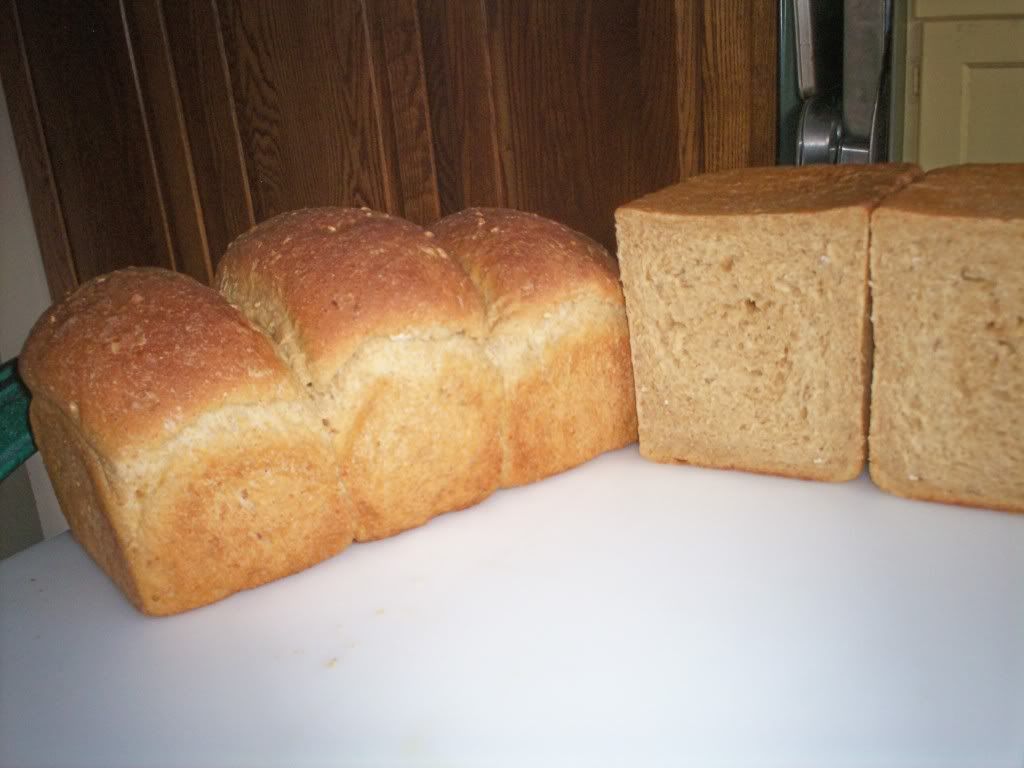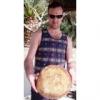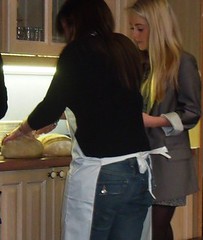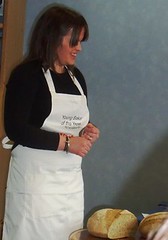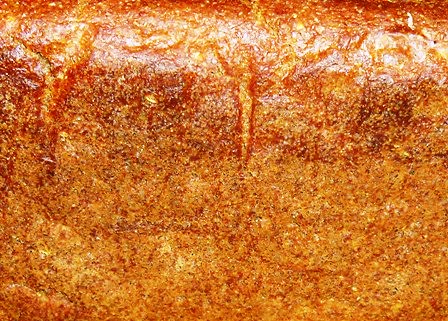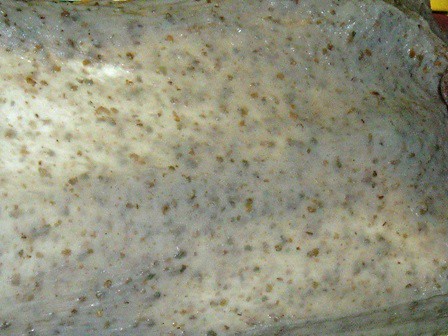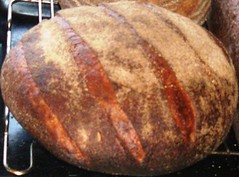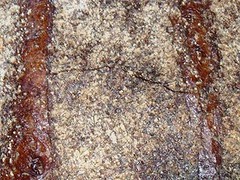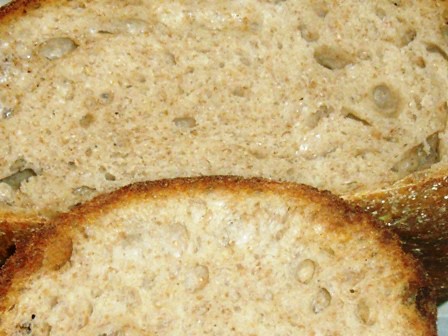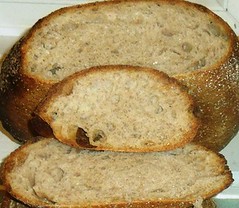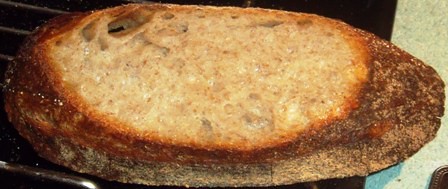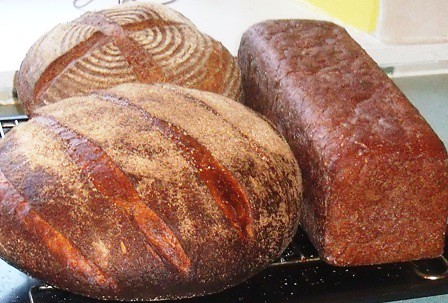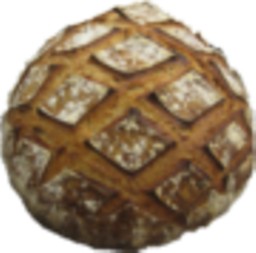(Apologies to Jimmy Buffett)
One of the many objectives of the formula development project is to gain understanding of the baking process. I have found that nothing beats working with the same general dough over and over, with very minor variations to understand the impact of various elements of the baking process.
So when comments on my last entry wound around to "intensive mix" vs. "improved mix" and the somewhat weak crumb of my last loaf, I really wanted to give them full consideration.
I may have mentioned elsewhere on these pages that my so called "normal" life contains, as a major feature, participating in the "security theatre" that is enjoying a long run in airports near you. Leaving discussion of the politics aside, it does provide me with long spaces of time where thoughts can roam free and it is wisest and best that they stray far from my actual circumstances and focus on something more pleasant - like bread.
I was idly mulling over intensive mix, when in one of those spooky out of body experiences that the doctors at The Place worry about - The Voice in My Head (known also as "my teacher") came rushing in on me. (It has been too long since I actually worked with "my teacher" - a situation to be remedied this year when I may be pushing it to overkill - and believe me, if you don't think I am studying and practicing in preparation for this - then I have not expressed myself well on these pages. This frenzied activity could explain a lot.)
"Pat, please tell me two ways to achieve dough development."
"One is through the action of the mixer and another is through time - that is the time spent in bulk fermentation - and folds, sensei."
"And beyond the ingredients what produces flavor in bread?"
"Time and folds, sensei."
"What have I said about intensive mix?"
"That it is fine for panned breads where all one wants is to achieve is volume and one doesn't care about flavor, sensei."
"And why would someone who uses intensive mix see no value in a bulk ferment?"
"Because the dough is fully developed coming off the mix and many of the carotenoid pigments have been destroyed by the oxidation of the mixing process, so the bulk ferment is essentially working with damaged goods, sensei."
"Is intensive mix ever appropriate?"
"Yes, yes it is, but it will be a different style of bread than those made with longer fermentation times, sensei."
"Speaking of volume - what does bread do best at high altitudes?"
"Rises and achieves volume often collapsing in the oven since it rises higher than the baked supporting structure can sustain - forcing us to deliberately reduce the rising, sensei."
"What must be perfect?"
"Everything, sensei?"
"You sound like you are asking."
"Everything, sensei."
"You know what to do. Bake and evaluate."
Coming to with my hands above my head and a TSA officer telling me that I could go stand on the mat, I knew what I must do.
Later, at home, giving the evening pizza crust a good twirl (my teacher once told me that this was a skill that s/he lacked and so I became obsessed with learning to twirl pizza crust) and reflecting that I had brought it to full twirl worthy development with nothing but time and some strokes with a plastic scraper, I reflected that there are indeed many ways to achieve a well developed dough.
On the formula development front, I wanted to add an inclusion in the dough and had settled on flax seed. I'm a big fan of flax - it being the thing that produces my favorite cloth - and this bread being a reflection of my favorite things; it seemed to be the logical choice.
I had some golden flax seed in the pantry and decided to use that. I created a soaker that seemed for all the world to be "hydration neutral" - it released no water when I put it in a sieve and seemed to have no droplets in the container that held it. Alas, as I added it to the mix, it did release some water and the dough hydration changed just a bit. Not enough ruin the dough, but definitely a change. Truly, I will be asking questions on this concept in the near future.
I also decided to use bread flour (not high gluten flour) as a way to produce a somewhat tougher crumb - although I regret this decision because I will now have to go back and test the formula with all purpose flour, anyway. It would be cheap and easy to just call for bread flour, but as I have told many clients - I'm easy, but I'm not cheap.
I mixed the dough for the six minutes that I had mixed it before - I feel that I might be able to mix it less, but I realize that My Precioussss is somewhat under loaded with this volume of dough and its efficiency is somewhat less at that load. I also wanted to recheck my dough development at this timing for the mix to satisfy myself that last week's crumb was not a result of poor dough development. It was a sufficiently developed at six minutes. No, it did not create the glove like windowpane as required by the shredibly soft loaf, but this dough is full of oat flakes and steel cut oats and these are going to keep that type of windowpane from forming no matter how long I mixed. The dough development was fine, and next time I will actually mix a bit less.
What I did do was degas the dough better and put a little more muscle into my shaping. I also watched the proof very carefully and didn't try to compensate for pan size by proofing longer.
The golden flax seed no doubt added some nutrition to the bread and did create a subtle and pleasant taste change, but it didn't create the hoped for "pretty bread." The crumb, however, was firm enough to hold a rather overstuffed grilled cheese and salsa sandwich, so I think I'll (sort of) be declaring victory on getting the crumb right by getting the shaping and proofing right.
As I said before, now the work begins. I will be switching out the golden flaxseed for regular flaxseed next week and have high hopes that I will get me my pretty bread at last. But now I have to understand if I can use all purpose flour, get exact mixing times, get a better read on the soakers -and get exact weights for each type of pan and each type of shape that I wish to make. This is tedious in the extreme and I will probably suspend my posting on this until I can organize a tasting to compare the original- original and a couple of versions of my variations. I don't know if my version will "sell out at bake sales" yet, but as I taste it, it has that elusive quality of "balance." I can taste the molasses in the bread, but I can also taste the grain- it has little crunchies, but I don't fear breaking a tooth. If anything, the crumb is a little too light (although it passed the spread butter and the gloppy sandwich test) but by no means unacceptable. I've got a niggling little voice telling me I need to mill a lot more triticale and get to that ill conceived experiment of a high percent of pre fermented flour, some yeast and a pan and gardening/pond cleaning season is fast approaching - so plenty of other things to do while I make tedious small tweaks.
Pictures and formula follow.
|
Total Dough Wt
|
|
72.88
|
oz
|
|
|
|
|
|
|
|
|
|
|
|
Ingredients
|
|
|
Soaker
|
|
|
Percent of Flour in Levain
|
0.1
|
|
Final Dough
|
|
|
|
|
%
|
Wt
|
UOM
|
|
|
|
%
|
WT
|
UOM
|
Ingredients
|
Wt
|
UOM
|
|
Total Flour
|
1.00
|
27
|
oz
|
|
|
|
1
|
2.7
|
oz
|
Total Flour
|
24.30
|
oz
|
|
Whole Wheat Flour
|
0.30
|
8.1
|
oz
|
|
|
|
|
|
|
Whole Wheat Flour
|
8.10
|
oz
|
|
KA AP Flour
|
0.60
|
16.2
|
oz
|
|
|
|
|
|
|
KA AP Flour
|
16.20
|
oz
|
|
Triticale Flour
|
0.10
|
2.7
|
oz
|
|
|
|
1
|
2.7
|
oz
|
|
|
|
|
Additional Water
|
0.14
|
3.7
|
oz
|
|
|
|
0.6
|
1.62
|
oz
|
Additional Water
|
2.08
|
oz
|
|
Rolled Oats
|
0.17
|
4.59
|
oz
|
|
|
|
|
|
|
Rolled Oats
|
4.59
|
oz
|
|
Steel Cut Oats
|
0.11
|
2.97
|
oz
|
|
|
|
|
|
|
Steel Cut Oats
|
2.97
|
oz
|
|
Boiling water
|
0.74
|
19.98
|
oz
|
|
|
|
|
|
|
Boiling water
|
19.98
|
oz
|
|
Shortening(leaf lard)
|
0.03
|
0.81
|
oz
|
|
|
|
|
|
|
Shortening(leaf lard)
|
0.81
|
oz
|
|
Molasses
|
0.06
|
1.62
|
oz
|
|
|
|
|
|
|
Molasses
|
1.62
|
oz
|
|
Agave Nectar
|
0.05
|
1.35
|
oz
|
|
|
|
|
|
|
Agave Nectar
|
1.35
|
oz
|
|
Milk Powder
|
0.04
|
1.08
|
oz
|
|
|
|
|
|
|
Milk Powder
|
1.08
|
oz
|
|
Salt
|
0.03
|
0.756
|
oz
|
|
|
|
|
|
|
Salt
|
0.76
|
oz
|
|
Yeast
|
0.004
|
0.108
|
oz
|
|
|
|
|
|
|
Yeast
|
0.11
|
oz
|
|
|
|
|
|
|
|
|
|
|
|
|
|
|
|
Golden Flax Seeds
|
0.1
|
2.7
|
oz
|
0.1
|
2.7
|
oz
|
|
|
|
|
|
|
|
Soaker Water
|
0.22
|
6
|
oz
|
0.22
|
6
|
oz
|
|
|
|
Soaker
|
8.7
|
oz
|
|
|
|
|
|
|
|
|
|
|
|
|
|
|
|
Seed
|
0.008
|
0.216
|
oz
|
|
|
|
0.08
|
0.216
|
oz
|
Levain
|
4.536
|
oz
|
|
Totals
|
2.399259259
|
72.88
|
oz
|
|
8.7
|
oz
|
1.68
|
4.536
|
oz
|
|
72.88
|
|
Prepare the soaker - allow to soak 12 hours
Prepare the pre ferment - allow to mature 12 hours
Pour the boiling water over the two types of oats and allow to cool to lukewarm
Combine all ingredients except the soaker and mix 6 minutes in one speed spiral (or to moderate development by any means desired.)
Add soaker and mix only until combined (I did this mostly by hand).
Bulk ferment 4 hours - one fold
Shape
Proof 1 hour
Place in oven at 375F - immediately decrease temp to 360F and bake 45-50 minutes (I actually bake about 45 minutes and then remove the bread from the pan, return it to the oven, and bake 5 minutes - more as this gives a nicer crust on the sides - but this will be one of those minor tedious tweaks.)
Remove from pans and cool.
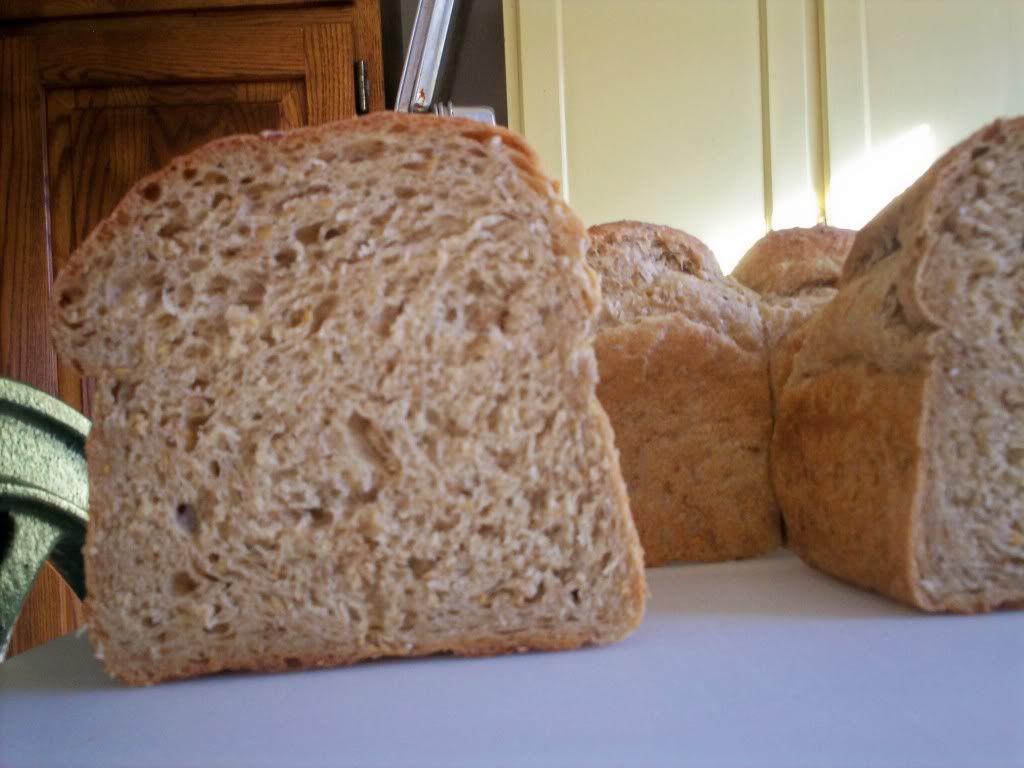
Have Fun!
Added by edit: I was just reflecting on the process and looked at a picture of the bread at the beginning. I thought I would post it here so the contrast was evident. Hardly the same loaf at all!
